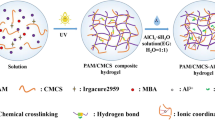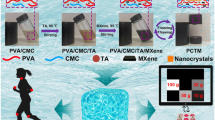Abstract
Hydrogel-based strain sensors have been widely investigated owing to their intrinsic flexible and extensible properties. However, integrating good mechanical properties and excellent strain sensitivity into one hydrogel remains a challenge. In this work, a dual physical cross-linked carboxymethyl cellulose-Fe3+/polyacrylamide (CMC-Fe3+/PAAm) double network hydrogel was developed by facile two-step method. In this hydrogel, the Fe3+ cross-linked CMC acts as the first network for dissipating energy and hydrophobic association PAAm acts as the second network to maintain the integrity of hydrogel. Owing to these physical interactions, the as-prepared hydrogel shows good mechanical properties (e.g., tensile strength, 1.82 MPa; toughness, 6.52 MJ/m3). Furthermore, these mechanical behaviors can be modulated by adjusting the solid content, CMC/PAAm ratio, Fe3+ concentration and soaking time in Fe3+ solution. Moreover, the obtained hydrogel shows excellent self-recovery and anti-fatigue property due to the reversibility of dual physical cross-linked interactions. Additionally, the CMC-Fe3+/PAAm hydrogel shows good conductivity (1.82 S/m), strain sensitivity (gauge factor = 4.02 at 50–600% strain), and fast response time (260 ms). Based on the high strain sensitivity, the CMC-Fe3+/PAAm hydrogel can fabricate a flexible strain sensor for precisely monitoring various human motions. This study suggests that the CMC-Fe3+/PAAm hydrogel exhibits potential application in the flexible and stretchable strain sensors.
Graphic abstract








Similar content being viewed by others
References
Amjadi M, Pichitpajongkit A, Lee S et al (2014) Highly stretchable and sensitive strain sensor based on silver nanowire-elastomer nanocomposite. ACS Nano 8:5154–5163. https://doi.org/10.1021/nn501204t
Cakici M, Reddy KR, Alonso-Marroquin F (2017) Advanced electrochemical energy storage supercapacitors based on the flexible carbon fiber fabric-coated with uniform coral-like MnO2 structured electrodes. Chem Eng J 309:151–158. https://doi.org/10.1016/j.cej.2016.10.012
Chen Q, Zhu L, Zhao C et al (2013) A robust, one-pot synthesis of highly mechanical and recoverable double network hydrogels using thermoreversible sol–gel polysaccharide. Adv Mater 25:4171–4176. https://doi.org/10.10020/adma.201300817
Chen Q, Zhu L, Huang L et al (2014) Fracture of the physically cross-linked first network in hybrid double network hydrogels. Macromolecules 47:2140–2148. https://doi.org/10.1021/ma402542r
Chen G, Huang J, Gu J et al (2020) Highly tough supramolecular double network hydrogel electrolytes for an artificial flexible and low-temperature tolerant sensor. J Mater Chem A 8:6776–6784. https://doi.org/10.1039/d0ta00002g
Choong CL, Shim MB, Lee BS et al (2014) Highly stretchable resistive pressure sensors using a conductive elastomeric composite on a micropyramid array. Adv Mater 26:3451–3458. https://doi.org/10.1002/adma.201305182
Dai X, Zhang Y, Gao L et al (2015) A mechanically strong, highly stable, thermoplastic, and self-healable supramolecular polymer hydrogel. Adv Mater 27:3566–3571. https://doi.org/10.1002/adma.201500534
Ding Y, Zhang J, Chang L et al (2017) Preparation of high-performance ionogels with excellent transparency, good mechanical strength, and high conductivity. Adv Mater 29:1–7. https://doi.org/10.1002/adma.201704253
Gong JP (2010) Why are double network hydrogels so tough? Soft Matter 6:2583–2590. https://doi.org/10.1039/b924290b
Gong JP, Katsuyama Y, Kurokawa T, Osada Y (2003) Double-network hydrogels with extremely high mechanical strength. Adv Mater 15:1155–1158. https://doi.org/10.1002/adma.200304907
Gong XL, Xiao YY, Pan M et al (2016a) PH- and thermal-responsive multishape memory hydrogel. ACS Appl Mater Interfaces 8:27432–27437. https://doi.org/10.1021/acsami.6b09605
Gong Z, Zhang G, Zeng X et al (2016b) High-strength, tough, fatigue resistant, and self-healing hydrogel based on dual physically cross-linked network. ACS Appl Mater Interfaces 8:24030–24037. https://doi.org/10.1021/acsami.6b05627
Hu Y, Du Z, Deng X et al (2016) Dual physically cross-linked hydrogels with high stretchability, toughness, and good self-recoverability. Macromolecules 49:5660–5668. https://doi.org/10.1021/acs.macromol.6b00584
Jiang X, Xiang N, Wang J et al (2017) Preparation and characterization of hybrid double network chitosan/poly(acrylic amide-acrylic acid) high toughness hydrogel through Al3+ crosslinking. Carbohydr Polym 173:701–706. https://doi.org/10.1016/j.carbpol.2017.06.003
Joorabloo A, Khorasani MT, Adeli H et al (2019) Fabrication of heparinized nano ZnO/poly(vinylalcohol)/carboxymethyl cellulose bionanocomposite hydrogels using artificial neural network for wound dressing application. J Ind Eng Chem 70:253–263. https://doi.org/10.1016/j.jiec.2018.10.022
Lee SY, Ogawa A, Kanno M et al (2010) Nonhumidified intermediate temperature fuel cells using protic ionic liquids. J Am Chem Soc 132:9764–9773. https://doi.org/10.1021/ja102367x
Lee GH, Moon H, Kim H et al (2020) Multifunctional materials for implantable and wearable photonic healthcare devices. Nat Rev Mater 5:149–165. https://doi.org/10.1038/s41578-019-0167-3
Li J, Suo Z, Vlassak JJ (2014) Stiff, strong, and tough hydrogels with good chemical stability. J Mater Chem B 2:6708–6713. https://doi.org/10.1039/c4tb01194e
Li CH, Wang C, Keplinger C et al (2016) A highly stretchable autonomous self-healing elastomer. Nat Chem 8:618–624. https://doi.org/10.1038/nchem.2492
Li N, Chen G, Chen W et al (2017a) Multivalent cations-triggered rapid shape memory sodium carboxymethyl cellulose/polyacrylamide hydrogels with tunable mechanical strength. Carbohydr Polym 178:159–165. https://doi.org/10.1016/j.carbpol.2017.09.030
Li N, Chen W, Chen G, Tian J (2017b) Rapid shape memory TEMPO-oxidized cellulose nanofibers/polyacrylamide/gelatin hydrogels with enhanced mechanical strength. Carbohydr Polym 171:77–84. https://doi.org/10.1016/j.carbpol.2017.04.035
Li X, Yang Q, Zhao Y et al (2017c) Dual physically crosslinked double network hydrogels with high toughness and self-healing properties. Soft Matter 13:911–920. https://doi.org/10.1039/c6sm02567f
Li X, Zhao Y, Li D et al (2017d) Hybrid dual crosslinked polyacrylic acid hydrogels with ultrahigh mechanical strength, toughness and self-healing properties via soaking salt solution. Polymer (Guildf) 121:55–63. https://doi.org/10.1016/j.polymer.2017.05.070h
Li H, Wang H, Zhang D et al (2018) A highly tough and stiff supramolecular polymer double network hydrogel. Polymer (Guildf) 153:193–200. https://doi.org/10.1016/j.polymer.2018.08.029
Liao X, Chen G, Liu X et al (2010) Photoresponsive pseudopolyrotaxane hydrogels based on competition of host-guest interactions. Angew Chem Int Ed 49:4409–4413. https://doi.org/10.1002/anie.201000141
Lin P, Ma S, Wang X, Zhou F (2015) Molecularly engineered dual-crosslinked hydrogel with ultrahigh mechanical strength, toughness, and good self-recovery. Adv Mater 27:2054–2059. https://doi.org/10.1002/adma.201405022
Mukhopadhyay RD, Das G, Ajayaghosh A (2018) Stepwise control of host-guest interaction using a coordination polymer gel. Nat Commun 9:1–9. https://doi.org/10.1038/s41467-018-04303-8
Niu R, Qin Z, Ji F et al (2017) Hybrid pectin-Fe3+/polyacrylamide double network hydrogels with excellent strength, high stiffness, superior toughness and notch-insensitivity. Soft Matter 13:9237–9245. https://doi.org/10.1039/c7sm02005h
Pang J, Wang L, Xu Y et al (2020) Skin-inspired cellulose conductive hydrogels with integrated self-healing, strain, and thermal sensitive performance. Carbohydr Polym 240. https://doi.org/10.1016/j.carbpol.2020.116360
Park S, Heo SW, Lee W et al (2018) Self-powered ultra-flexible electronics via nano-grating-patterned organic photovoltaics. Nature 561:516–521. https://doi.org/10.1038/s41586-018-0536-x
Peng L, Zhu Y, Li H, Yu G (2016) Chemically integrated inorganic-graphene two-dimensional hybrid materials for flexible energy storage devices. Small 12:6183–6199. https://doi.org/10.1002/smll.201602109
Qin Z, Niu R, Tang C et al (2018) A dual-crosslinked strategy to construct physical hydrogels with high strength, toughness, good mechanical recoverability, and shape-memory ability. Macromol Mater Eng 303:1–12. https://doi.org/10.1002/mame.201700396
Qin Z, Sun X, Yu Q et al (2020a) Carbon nanotubes/hydrophobically associated hydrogels as ultrastretchable, highly sensitive, stable strain, and pressure sensors. ACS Appl Mater Interfaces 12:4944–4953. https://doi.org/10.1021/acsami.9b21659
Qin Z, Sun X, Zhang H et al (2020b) A transparent, ultrastretchable and fully recyclable gelatin organohydrogel based electronic sensor with broad operating temperature. J Mater Chem A 8:4447–4456. https://doi.org/10.1039/c9ta13196e
Son D, Lee J, Qiao S et al (2014) Multifunctional wearable devices for diagnosis and therapy of movement disorders. Nat Nanotechnol 9:397–404. https://doi.org/10.1038/nnano.2014.38
Sun JY, Zhao X, Illeperuma WRK et al (2012) Highly stretchable and tough hydrogels. Nature 489:133–136. https://doi.org/10.1038/nature11409
Sun TL, Kurokawa T, Kuroda S et al (2013) Physical hydrogels composed of polyampholytes demonstrate high toughness and viscoelasticity. Nat Mater 12:932–937. https://doi.org/10.1038/nmat3713
Sun JY, Keplinger C, Whitesides GM, Suo Z (2014) Ionic skin. Adv Mater 26:7608–7614. https://doi.org/10.1002/adma.201403441
Sun Y, Sills RB, Hu X et al (2015) A bamboo-inspired nanostructure design for flexible, foldable, and twistable energy storage devices. Nano Lett 15:3899–3906. https://doi.org/10.1021/acs.nanolett.5b00738
Sun X, Qin Z, Ye L et al (2020) Carbon nanotubes reinforced hydrogel as flexible strain sensor with high stretchability and mechanically toughness. Chem Eng J 382:122832. https://doi.org/10.1016/j.cej.2019.122832
Tang Y, Zhang X, Zhao R et al (2018) Preparation and properties of chitosan/guar gum/nanocrystalline cellulose nanocomposite films. Carbohydr Polym 197:128–136. https://doi.org/10.1016/j.carbpol.2018.05.073
Tuncaboylu DC, Sari M, Oppermann W, Okay O (2011) Tough and self-healing hydrogels formed via hydrophobic interactions. Macromolecules 44:4997–5005. https://doi.org/10.1021/ma200579v
Wang W, Zhang Y, Liu W (2017) Bioinspired fabrication of high strength hydrogels from non-covalent interactions. Prog Polym Sci 71:1–25. https://doi.org/10.1016/j.progpolymsci.2017.04.001
Wang C, Fadeev M, Zhang J et al (2018) Shape-memory and self-healing functions of DNA-based carboxymethyl cellulose hydrogels driven by chemical or light triggers. Chem Sci 9:7145–7152. https://doi.org/10.1039/c8sc02411a
Wu X, Sun H, Qin Z et al (2020) Fully physically crosslinked pectin-based hydrogel with high stretchability and toughness for biomedical application. Int J Biol Macromol 149:707–716. https://doi.org/10.1016/j.ijbiomac.2020.01.297
Xu J, Jin R, Ren X, Gao G (2019a) Cartilage-inspired hydrogel strain sensors with ultrahigh toughness, good self-recovery and stable anti-swelling properties. J Mater Chem A 7:25441–25448. https://doi.org/10.1039/c9ta09170j
Xu J, Wang G, Wu Y et al (2019b) Ultrastretchable wearable strain and pressure sensors based on adhesive, tough, and self-healing hydrogels for human motion monitoring. ACS Appl Mater Interfaces 11:25613–25623. https://doi.org/10.1021/acsami.9b08369
Yu Q, Qin Z, Ji F et al (2021) Low-temperature tolerant strain sensors based on triple crosslinked organohydrogels with ultrastretchability. Chem Eng J 404:126559. https://doi.org/10.1016/j.cej.2020.126559
Zang Y, Zhang F, Di CA, Zhu D (2015) Advances of flexible pressure sensors toward artificial intelligence and health care applications. Mater Horizons 2:140–156. https://doi.org/10.1039/c4mh00147h
Zhai W, Xia Q, Zhou K et al (2019) Multifunctional flexible carbon black/polydimethylsiloxane piezoresistive sensor with ultrahigh linear range, excellent durability and oil/water separation capability. Chem Eng J 372:373–382. https://doi.org/10.1016/j.cej.2019.04.142
Zhang S, Liu H, Yang S et al (2019) Ultrasensitive and highly compressible piezoresistive sensor based on polyurethane sponge coated with a cracked cellulose nanofibril/silver nanowire layer. ACS Appl Mater Interfaces 11:10922–10932. https://doi.org/10.1021/acsami.9b00900
Acknowledgments
This work was supported by the National Natural Science Funds for Excellent Young Scholars (No. 31722022), the National Key Research and Development Program of China (No. 2018YFC1105500), and the National Natural Science Foundation of China (Nos. 31870948 and 31971250).
Author information
Authors and Affiliations
Corresponding authors
Ethics declarations
Conflict of interest
The authors declare that they have no conflict of interest.
Additional information
Publisher's Note
Springer Nature remains neutral with regard to jurisdictional claims in published maps and institutional affiliations.
Electronic supplementary material
Below is the link to the electronic supplementary material.
Rights and permissions
About this article
Cite this article
Zhang, H., Wu, X., Qin, Z. et al. Dual physically cross-linked carboxymethyl cellulose-based hydrogel with high stretchability and toughness as sensitive strain sensors. Cellulose 27, 9975–9989 (2020). https://doi.org/10.1007/s10570-020-03463-5
Received:
Accepted:
Published:
Issue Date:
DOI: https://doi.org/10.1007/s10570-020-03463-5




